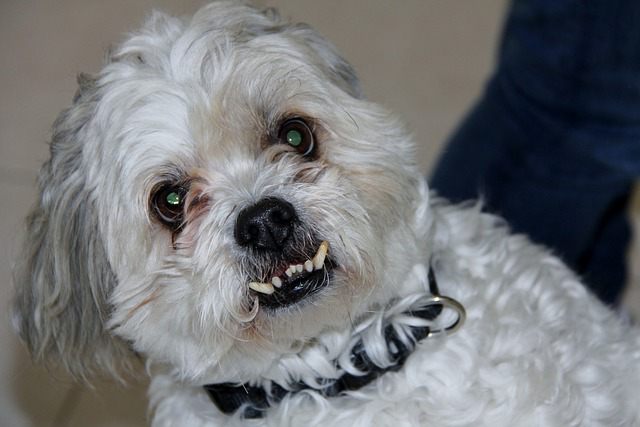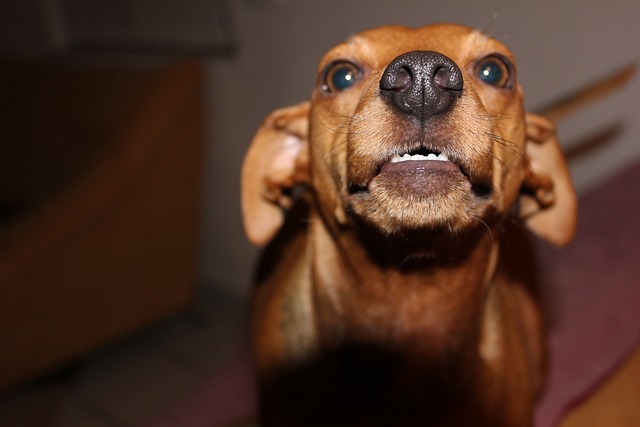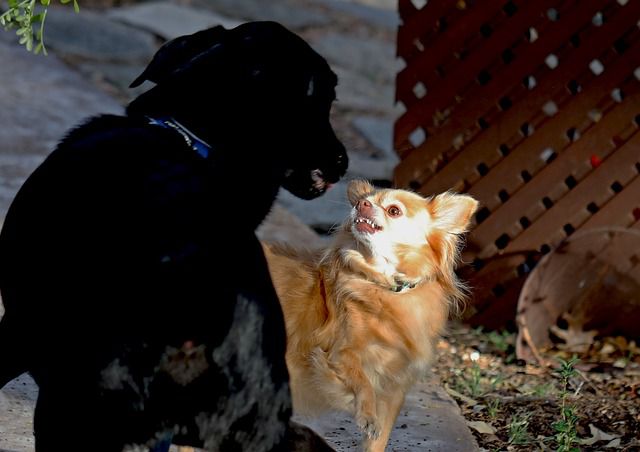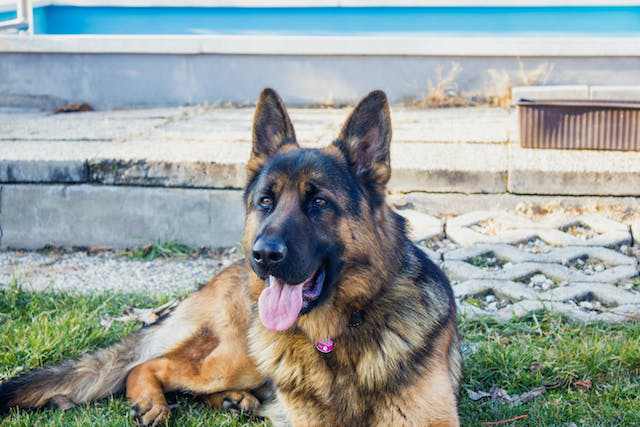Today, we’re going to tackle a topic that can sometimes be a bit tricky – protective aggression in dogs.
It’s important to understand that our furry friends have instincts that drive them to protect us, but it’s equally important to address any aggressive behavior in a safe and responsible manner.
So, grab a cup of coffee, and let’s dive into this fascinating subject together!
What is Protective Aggression in Dogs?
Protective aggression in dogs refers to a behavior where a dog displays aggression towards perceived threats in order to protect themselves, their territory, or their family.
This type of aggression is often seen in dogs that have a strong protective instinct and may manifest as barking, growling, lunging, or even biting.
It is important to note that while protective aggression may be instinctual, it can be managed and modified through proper training and socialization.
If you are dealing with a dog displaying protective aggression, it is recommended to seek the assistance of a professional dog trainer or behaviorist to address the issue effectively.
Signs of Protective Aggression in Dogs

Protective aggression in dogs can be identified through a set of behavioral signs. One sign is excessive barking or growling when someone approaches their territory or their owner.
Another sign is displaying a stiff body posture, with raised hackles and a tense facial expression. Dogs may also exhibit lunging or charging behavior towards perceived threats, accompanied by an intense stare.
In some cases, dogs may bite or nip at individuals whom they perceive as a threat. It’s important to note that protective aggression is different from fear aggression, as it is triggered by a desire to defend rather than a fear response.
Understanding these signs can help dog owners recognize and address protective aggression in their pets.
Read more about identifying dog aggression.
Causes of Protective Aggression in Dogs

Protective aggression in dogs is a behavior that is often triggered by a perceived threat towards their territory, family, or resources. There are several major causes of protective aggression in dogs.
Firstly, a lack of proper socialization during the critical development period can lead to dogs being overly protective.
Secondly, previous traumatic experiences, such as abuse or attacks, can contribute to a dog’s protective aggression.
Thirdly, genetic predisposition and breed traits can play a role in certain dogs being more prone to protective aggression.
Additionally, inadequate training and reinforcement of appropriate behaviors can contribute to the development of protective aggression.
Moreover, fear and anxiety can also contribute to a dog’s protective aggression, as they may perceive the situation as threatening.
Lastly, inconsistency or confusion in the dog’s environment and interactions with humans can lead to a heightened sense of protectiveness.
Understanding these causes can help dog owners and trainers address and manage protective aggression effectively.
Read more about things that will lead to aggression in dogs.
Addressing and Managing Protective Aggression in Dogs

Protective aggression in dogs can be a challenging behavior to address and manage. It is important to approach this issue with patience, consistency, and a focus on positive reinforcement.
Here are some effective ways to address and manage protective aggression in dogs:
1. Identify Triggers
Identifying the triggers that elicit protective aggression is a critical step in managing this behavior.
Triggers can vary from dog to dog but commonly include territoriality, resource guarding, fear, and anxiety.
By understanding what sets off your dog’s aggression, you can take proactive steps to manage and modify their behavior.
Keep a journal or record of incidents to help identify patterns and potential triggers.
2. Consult with a Veterinarian
It is crucial to consult with a veterinarian to rule out any underlying medical conditions that may be contributing to the aggressive behavior.
Certain medical conditions, such as pain or hormonal imbalances, can manifest as aggression in dogs.
A thorough examination and appropriate diagnostic tests can help identify and address any underlying health issues.
3. Professional Training
Seeking the guidance of a professional dog trainer or behaviorist who specializes in aggression issues is highly recommended.
They can assess your dog’s behavior, identify triggers, and develop a customized training plan.
A professional will have the knowledge and experience to implement effective behavior modification techniques and teach you the appropriate methods for managing your dog’s protective aggression.
4. Counterconditioning and Desensitization
Counterconditioning and desensitization techniques are often used in behavior modification plans for dogs with protective aggression.
This involves gradually exposing the dog to the trigger that elicits aggression, starting at a distance where the dog remains calm, and pairing the trigger with positive experiences such as treats, praise, or play.
Over time, the dog learns to associate the trigger with positive outcomes, leading to a change in their emotional response.
5. Positive Reinforcement
Positive reinforcement is a powerful training technique that involves rewarding desired behaviors with treats, praise, or play.
When addressing protective aggression, it is important to reward calm and non-aggressive behavior.
For example, if your dog remains calm when encountering a trigger, reward them immediately with treats and praise.
This approach helps reinforce the desired behavior and encourages the dog to make positive choices.
6. Controlled Socialization
Controlled socialization plays a significant role in reducing fear and anxiety, which can contribute to protective aggression.
It involves gradually introducing the dog to different people, animals, and environments in a controlled and positive manner.
The process should be gradual, starting with low-stress situations and gradually progressing to more challenging ones.
The dog should always be under close supervision during socialization exercises to prevent any negative experiences that may reinforce aggressive behavior.
7. Neutering/Spaying
Neutering or spaying your dog may help reduce territorial aggression. Hormonal changes that occur after the procedure can often lead to a decrease in certain types of aggression.
However, it is important to note that the effects of neutering/spaying on aggression can vary depending on individual dogs and their specific circumstances.
It is best to consult with your veterinarian to determine if this is a suitable option for your dog and to understand the potential benefits and risks involved.
8. Avoidance and Management
In situations where the dog is likely to display protective aggression, it is important to avoid or manage those situations to prevent the behavior from occurring.
This may involve keeping the dog away from triggers or using management tools such as muzzles or leashes when in public settings.
It is crucial to prioritize the safety of all individuals involved and gradually work on behavior modification with the guidance of a professional.
9. Consistency and Routine
Dogs thrive on consistency and routine, as it provides them with a sense of stability and security.
Establishing a consistent daily routine and providing clear boundaries and expectations can help reduce anxiety and prevent triggers for protective aggression.
Consistency in training methods and reinforcement techniques is also essential.
By being consistent, you help your dog understand what is expected of them and create an environment that promotes calm and non-aggressive behavior.
10. Patience and Time
Addressing and managing protective aggression in dogs takes time and patience.
It is essential to understand that every dog is unique, and progress may vary. Some dogs may respond quickly to training, while others may require more time and repetition.
It is important to stay committed to the training process, be patient with your dog, and celebrate small victories along the way.
Seek support from professionals and stay consistent in your efforts to help your dog overcome protective aggression.
Remember, each dog is an individual, and what works for one dog may not work for another. It is crucial to tailor the training and management techniques to meet the specific needs of your dog.
Read more about aggression in dogs.
Frequently Asked Questions
How can I identify protective aggression in my dog?
Signs of protective aggression may include growling, barking, lunging, or even biting when someone or something approaches their territory or family members. It is important to note that these behaviors can also be influenced by fear or anxiety, so professional evaluation is recommended.
Can protective aggression be managed or controlled?
Yes, with proper training and behavior modification techniques, protective aggression in dogs can be managed and controlled. Working with a professional dog trainer or behaviorist is often recommended to create a tailored plan for your dog’s specific needs.
Is protective aggression a breed-specific behavior?
While certain breeds may have a higher predisposition to exhibit protective aggression due to their guarding instincts, protective aggression can be observed in dogs of any breed or mix. It is important to remember that individual temperament and training play significant roles in a dog’s behavior.
Are there any warning signs or triggers for protective aggression?
Warning signs may include tense body posture, raised fur, fixed stare, and raised hackles. Triggers for protective aggression can vary from dog to dog, but they often include unfamiliar people or animals approaching their territory, sudden movements, or perceived threats to their family.
Can protective aggression be completely eliminated in dogs?
Completely eliminating protective aggression in dogs can be challenging, but it can be managed and significantly reduced through consistent training, behavior modification, and socialization. It’s important to work with professionals who can provide guidance and support throughout the process.
Read more about how to calm an aggressive dog.
Conclusion
In conclusion, dogs are incredible creatures who possess an innate instinct to protect their loved ones. While protective aggression can be a challenging behavior to manage, it is important for us as responsible pet owners to address it with patience, understanding, and proper training techniques. By working together, we can help our furry friends find a balance between their protective instincts and a peaceful coexistence in our homes.


